







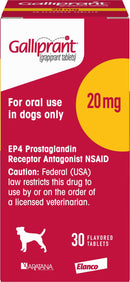


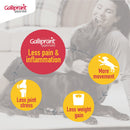

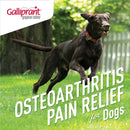
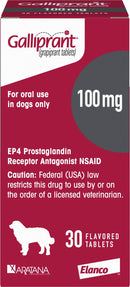
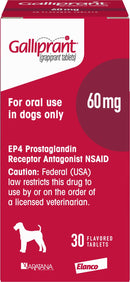
Galliprant is a prescription medication designed to treat your dog's osteoarthritis pain. It's an easy-to-give daily medication that can be used at the earliest signs of osteoarthritis, and may help your pal to feel better. Plus, it comes in a tablet, so you can easily hide it in your dog's wet food or a pill pocket to make administration even easier.
Uses
Galliprant (grapiprant tablets) is an NSAID indicated for the control of pain and inflammation associated with osteoarthritis in dogs.
Possible Side Effects
Please contact your veterinarian if your pet is vomiting, has diarrhea, decreased appetite, stools become abnormal and has decreasing albumin and total protein.
Drug & Food Interactions
Galliprant was used safely with other concurrent therapies, including antibiotics, parasiticides, and vaccinations.
Precautions
Not for use in humans. Keep out of reach of children and pets. Monitoring is recommended if used long term. Should not be used in dogs who are allergic to grapiprant or with other anti-inflammatory drugs. The safe use of Galliprant has not been studied in dogs younger than 9 months of age and less than 8 pounds, breeding, pregnant or lactating dogs, or dogs with heart disease. The most common adverse reactions were vomiting, diarrhea, decreased appetite and tiredness. View full product label for complete safety information or contact your veterinarian.
Ingredients
Grapiprant.
Recommended Dosage
Consult your veterinarian for specific dosing instructions; they will determine the lowest effective dose depending on your pet's needs and their response. The typical dose is 0.9 mg/lb (2 mg/kg) once daily.
Storage Instructions
Store at or below 86°F.
FAQ
What Is Canine Osteoarthritis?
Canine osteoarthritis is the most common cause of chronic pain in dogs, and it doesn't just occur in older, heavy dogs. It's a painful disease that causes inflammation and swelling in a dog's joints.
How Can You Tell If Your Dog Has Early Signs Of Osteoarthritis?
Your dog can't tell you about aches and pains, so it's up to you to watch for subtle warning signs of osteoarthritis pain and inflammation. No one knows your dog better than you do, so your veterinarian relies on you to notice changes in behavior.
Ask Yourself These Questions:
- Is my dog less interested in participating in usual activities?
- Does my dog seem less alert?
- Does my dog lag behind during walks?
- Is my dog overly cautious when navigating stairs, jumping up on the couch or getting in or out of the car?
- Is my dog sleeping more?
- Does my dog have difficulty getting up or lying down?
- Has my dog gained weight?
- Does my dog seem less interested in greeting me when I come home?
- If you answered yes to any of these questions, you should ask your veterinarian about possibly screening your dog for canine osteoarthritis.
What Does Galliprant Do?
Galliprant reduces pain and inflammation due to osteoarthritis in dogs It's safe to use daily and proven effective It’s a first-of-its-kind NSAID that targets pain by directly blocking the key receptor involved in canine osteoarthritis pain and inflammation Convenient, once-daily dosing in a flavored chewable tablet.
What Is Canine Osteoarthritis?
Canine osteoarthritis is the most common cause of chronic pain in dogs, and it doesn't just occur in older, heavy dogs. It's a painful disease that causes inflammation and swelling in a dog's joints.
How Can You Tell If Your Dog Has Early Signs Of Osteoarthritis?
Your dog can't tell you about aches and pains, so it's up to you to watch for subtle warning signs of osteoarthritis pain and inflammation. No one knows your dog better than you do, so your veterinarian relies on you to notice changes in behavior.
Ask Yourself These Questions:
- Is my dog less interested in participating in usual activities?
- Does my dog seem less alert?
- Does my dog lag behind during walks?
- Is my dog overly cautious when navigating stairs, jumping up on the couch or getting in or out of the car?
- Is my dog sleeping more?
- Does my dog have difficulty getting up or lying down?
- Has my dog gained weight?
- Does my dog seem less interested in greeting me when I come home?
- If you answered yes to any of these questions, you should ask your veterinarian about possibly screening your dog for canine osteoarthritis.
What is Galliprant?
Galliprant (grapiprant tablets) is a first-of-its-kind, non-steroidal anti-inflammatory (NSAID) that uses targeted action to treat canine osteoarthritis pain and inflammation. The convenient, flavored chewable tablet is safe to use daily. Your veterinarian may start treatment for your dog as early as 9 months of age and as soon as your dog is diagnosed with osteoarthritis to help keep your dog doing the things he loves.
How does Galliprant work?
Once osteoarthritis pain sets in, your dog is less likely to move and may put on a few extra pounds. This can lead to more stress on joints and even more inflammation and pain. Galliprant can help break the cycle by providing targeted osteoarthritis pain relief so your dog can continue doing the things he loves, like going on walks and playing fetch.
Can I give Galliprant to very large or small dogs?
Your veterinarian will prescribe the proper dose for your dog; talk with your veterinarian if you have questions. Your dog should not use Galliprant if less than 8 pounds of body weight. Dogs that weigh more than 150 pounds may require more than one tablet.
Can Galliprant be mixed with food?
Galliprant can be administered with or without food.
Is Galliprant a chewable or a hard pill?
Galliprant is available as a once daily, flavored chewable tablet.
How long can my dog use Galliprant?
As osteoarthritis is a chronic disease, Galliprant may need to be given for an extended period of time. Ask your veterinarian what's right for your dog and periodically discuss your dog's ongoing response to treatment.
Is Galliprant safe to use every day?
Yes! Galliprant is approved for daily use to provide targeted osteoarthritis pain relief so your dog can continue doing the things he loves, like going on walks and playing fetch. The most common side effects associated with Galliprant include vomiting, soft, mucoid stools, diarrhea, decreased appetite. You should contact your veterinarian if your dog's appetite decreases or stools become abnormal or if your dog experiences any other side effects.
Can I give Galliprant with other medications?
Galliprant was used (safely) during the field studies with other concurrent therapies, including antibiotics, parasiticides, and vaccinations. Galliprant should not be given with other non-steroidal anti-inflammatory drugs (NSAIDs) or corticosteroids (for example, aspirin, caprofen, meloxicam and prednisone). The concomitant use of protein-bound drugs with Galliprant has not been studied. Commonly used protein-bound drugs include cardiac, anticonvulsant and behavioral medications. Talk with your veterinarian about any medications your dog is taking, or that you plan to give your dog.
Can I give Galliprant with joint supplements?
It's important to tell your veterinarian about all medications that you are giving your dog or plan to give your dog, including those you can get without a prescription and any dietary supplements. Your veterinarian can help you determine whether adding a joint supplement is appropriate for your dog.
Can Galliprant be given to a dog with food allergies?
Galliprant contains pork liver as the flavoring agent. It is up to your veterinarian to determine the best course of treatment in a potentially allergic dog.
Can dogs with other chronic diseases (such as diabetes, kidney or liver disease) take Galliprant?
You should discuss any other conditions your dog has with your veterinarian to determine whether or not it is safe for your dog to take Galliprant.
What is the shelf life of Galliprant?
See the expiration date that has been provided on the prescription your dog receives. Ask your veterinarian if you have questions.
